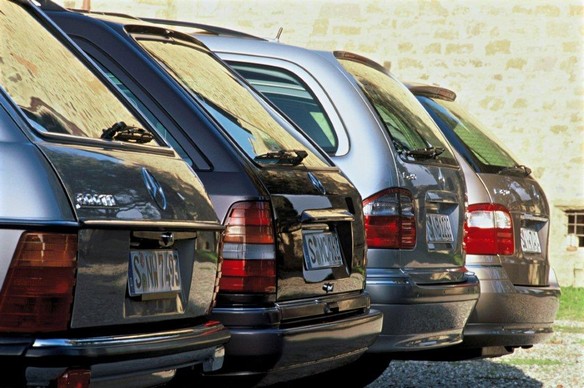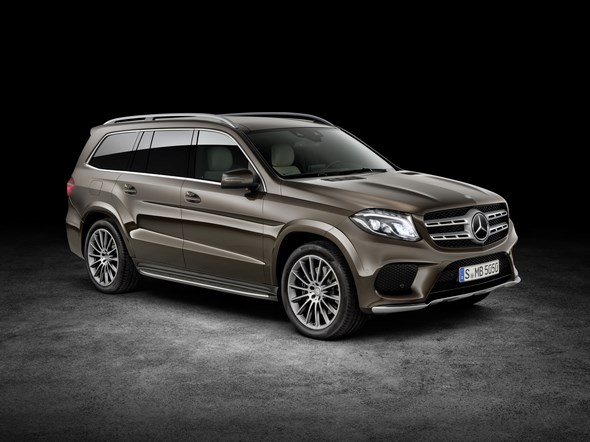Modern classics: the Estates of the Mercedes-Benz 124 series (1985 – 1996)


- The perfect vehicle for people with an active lifestyle
- First large-scale use worldwide of four-valve-per-cylinder technology in diesel engines in the 124 series
- A sophisticated suspension ensures safety and comfort
Stuttgart – The name E-Class has a good ring to it and is held in worldwide esteem. It stands for an entire model family from Mercedes-Benz whose tradition goes a long way back. But the first series to bear the name E-Class is not old: it is the 124 series launched in 1984.
[adsense]Since 1993 it went by the name of the E-Class – and passed this name on to all successor series. Today it is one of the brand’s modern classics that brings its workaday qualities to bear down to the very present and still makes a perfect companion. At Mercedes-Benz Young Classics in Stuttgart such cars are available for purchase or rent.
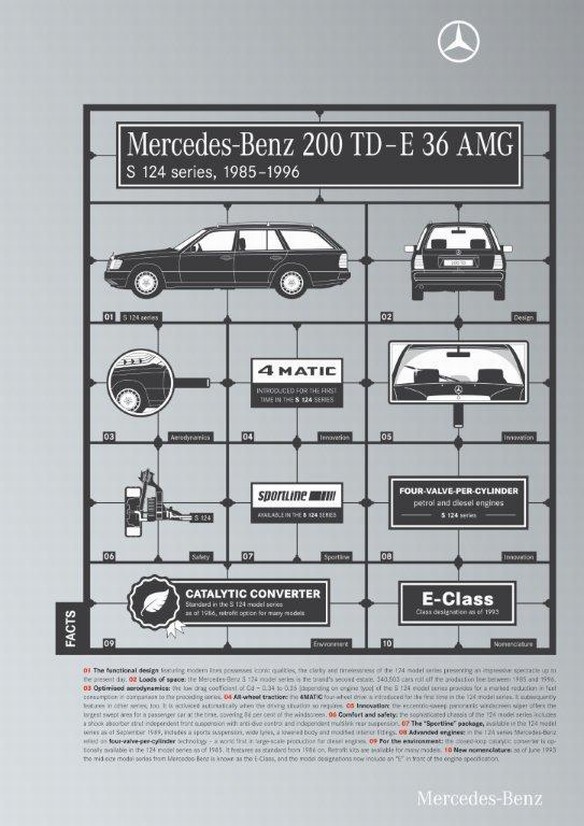
Mercedes-Benz introduced the Estate models in September 1985, one year after presenting the Saloon. As usual, they have an S in the internal designation: S 124. This was the second series of Estate models from the brand. The load artist had celebrated its debut in the previous series, the 123; the combination of saloon comfort with the load compartment capacity of an estate proved so successful that Mercedes-Benz offered this body type in the next generation too. Later the Estate model range was extended to the C-Class, and it has long enjoyed great popularity with the customers.
The success, the popularity and the quality of the 124 series in all variants – Saloon, Estate, Coupé, Cabriolet and special models – is reflected in the current figures. For example, in the USA just about 65,000 units are still on the road; in Germany, easily 55,550, and in France around 26,600 (as of September 2009). But these figures also show that in many cases the owners see their cars as a long-time companion and a lasting investment. With that the 124 series already has transformed into a classic – a modern classic, of course, but one that embodies values of the Mercedes-Benz brand which were just as valid then as they are today.
These values include comfort, an area in which Mercedes-Benz sets new standards every time again in its intermediate range. The engineers’ have an extremely comprehensive understanding of the term comfort: not just a pleasant atmosphere in the interior, with comfortable upholstery and high-grade materials, a sophisticated suspension system and refined engines create a sense of comfort, but the perfect interplay of all vehicle components. Drivers always have the feeling that with this vehicle they get the perfect mobility solution to suit their needs. The 124 series is a prime example of this philosophy.
Also where safety is concerned. The engineers created a very high standard with a whole package of solutions, including the use of high-strength steels in the body structure, which permit both a lightweight construction and great stability. In September 1988 all models of the series got an extended range of standard equipment which included the anti-locking braking system ABS and a heated nearside exterior mirror – safety features just like the windscreen washing unit with heated washer reservoir plus heated nozzles and hoses which were adopted from the S-Class on this occasion. Of course, the sophisticated suspension of the 124 series with inter alia shock absorber strut independent front suspension with anti-dive control and multi-link independent rear suspension also counts as a safety feature. Together with the Estate model the all-wheel-drive system 4MATIC also premiered. Like the automatic locking differential and acceleration skid control ASR systems combined with it, this system enhances handling safety in critical situations.
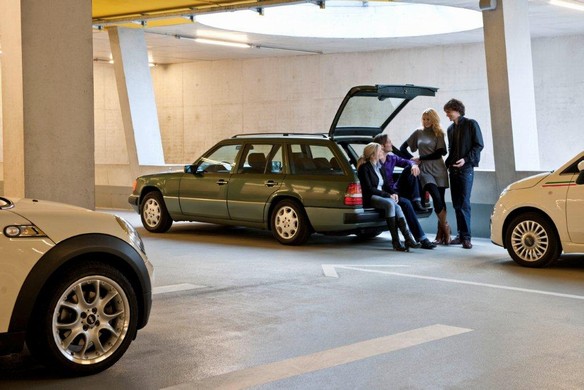
At the same time developments like these are typical of the innovative strength of the 124 series. The innovations included the eccentric-sweep panoramic windscreen wiper, which ensured a swept area that was the largest of any car. But the four-valve-per-cylinder technology also added a chapter to the series’ innovation story: as a world first in large-scale production it was introduced in the diesel engines; the petrol engines were systematically changed over to the four-valve technology in the course of the model’s history.
The design certainly has not lost its freshness. Cars of the 124 series still present an attractive picture, with their body lines giving them a classic, almost timeless appearance. The design underscores the brand’s claim that it offers its buyers not only a perfect automobile, but a made-to-measure suit, so to speak, appropriate for any occasion or situation in life.
The Estate models of the 124 series demonstrate workaday qualities in a truly characteristic way: their load compartment concept is as up-to-date today as it ever was. With their large capacity, the low load sill and the practical tailgate, the Estates are the ideal companions for people who cultivate an active lifestyle.
The longevity of the 124 series is almost proverbial. The figures provided earlier on the number of vehicles still in everyday operation speak a clear language. And one is safe in assuming that the number of kilometres in service usually will be in the high six-digit range – no problem at all owing to the well-thought-out overall design. But it also can be put down to the perfect supply of spare parts: almost every part is still available through the Mercedes-Benz service organisation. Not only those required to keep the car running, but also to guarantee a perfect visual condition.
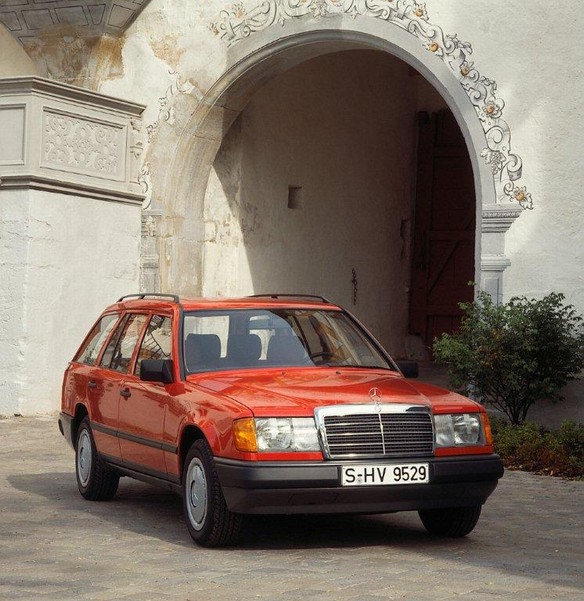
Model history: the Estates of the Mercedes-Benz 124 series
- Between 1985 and 1996 340,503 Estates rolled off the assembly line
- The all-wheel-drive system 4MATIC debuts in the 124 series
- The down-to-earth, functional design with modern lines impresses through clarity and timelessness
In 1984 Mercedes-Benz introduced the 124 series – the first family of vehicles that would be called the E-Class, though renaming did not occur until June 1993. At its debut, where traditionally only the Saloon is presented at first, the model designation followed the classic pattern. The history of the 124 series is marked by a previously unrivalled variety of models, body shapes and innovations. An important step in this connection was the presentation of the Estate in September 1985 at the International Motor Show in Frankfurt/Main.
This second generation of the sporty lifestyle Estate from Mercedes-Benz largely corresponds to the Saloon in its engineering and styling: apart from the deviating rear end design, the higher roof, and the changes which these gave rise to, there are no differences in the body. Major components, brake system and suspension merely were adapted to the higher payload, but otherwise were taken almost unchanged from the Saloon.
The safety standard achieved in the Saloon also was adopted as much as possible for the Estate models by the design engineers. In particular, the latest findings of safety research entered into the development of the rear body overhang, an especially critical region in estate car rear ends. One example is the fuel tank, which for design reasons is suspended underneath the vehicle floor in the Estates. It was given a special shape with sloping faces on the upper side of the tank and the vehicle floor. This ensures that in a rear-end collision involving deformation of the side members the tank is pushed down and away, but held by check straps so that it does not impact the road surface.
High-strength sheet steel and other weight-reducing materials already were used in the compact models of the 201 series. In the 124 series, despite lightweight construction the Mercedes-Benz engineers further improved the vehicle safety taking the 201 series and series 126
S-Class as benchmarks. The passenger compartment of the 124 series is distinguished by high side impact and rollover resistance and is provided with ingenious deformation zones in the front end and in the rear. The criterion of an asymmetric frontal collision with 40 percent overlap at a speed of 55 km/h now also was met by the Saloons of the intermediate series. In addition, possible areas of contact were designed to yield on impact to protect pedestrians and cyclists.
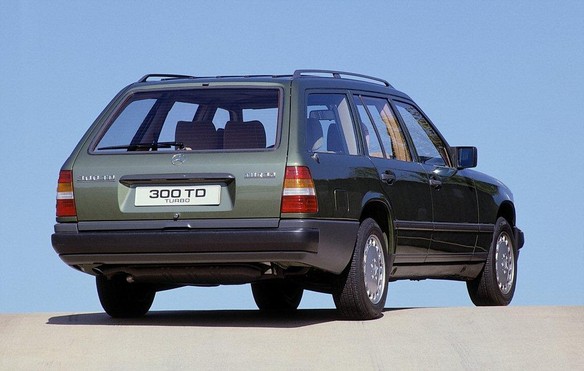
Individualist with family styling features
The design of the 124 series shows a family likeness to the compact models. On the whole, however, the new model series presented itself with independent design elements which had a functional background and were used for the first time. Bruno Sacco, Joseph Gallitzendörfer and Peter Pfeiffer were responsible for this design. The shape of the rear end both of the Saloon and the Estate had an especially favourable effect on drag resistance and was the product of wind tunnel testing. Aerodynamic optimisation measures resulted in a distinct reduction in fuel consumption versus the preceding model.
The much smaller Cd figure produced by the body design, as compared with the predecessor, brought a major improvement above all in fuel consumption. Compared with the Estate model with the internal designation S 123 the Cd was reduced from 0.42 to between 0.34 and 0.35, depending on engine.
An at first sight inconspicuous, but remarkably innovative design detail is the eccentric-sweep panoramic windscreen wiper. It wipes 86 percent of the windscreen – the biggest swept area of any car in the world at the time of the launching of the 124 series. Owing to a lifting motion superimposed on the rotary motion, the upper corners of the windscreen could be wiped far more efficiently than with a conventional single-arm wiper. Electrically heated windscreen washer nozzles were part of the standard equipment of all models of the series.
Chassis and engines
The front and rear suspension designs familiar from the compact models make for outstanding handling qualities. They include a shock absorber strut independent front suspension with anti-dive control, located by individual wishbones, and a multi-link independent rear suspension with each rear wheel located by five separate links and struts. The rear axle of the Estate models has hydropneumatic level control as standard.
The original Estate model range in the 124 series comprises seven models with different engines. The OM 601 of the 200 TD (53 kW) also powered the compact model 190 D with the same output. Other diesel models were the 250 TD (OM 602, 2.5 litres displacement, 66 kW) and the 300 TD with a three-litre six-cylinder (OM 603, 80 kW). In the 300 TD Turbo the 105 kW three-litre six-cylinder turbodiesel engine OM 603 A had its debut; the Mercedes-Benz engineers developed it from the naturally aspirated engine of the Saloon. The Estates with petrol engine were the four-cylinder models 200 T (80 kW) and 230 TE (100 kW) and the six-cylinder 300 TE (138 kW).
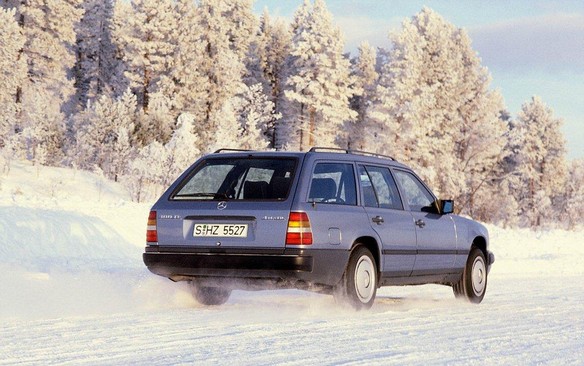
1985: 4MATIC is all-wheel-drive culture at Mercedes-Benz level
Simultaneously with the Estate models Stuttgart introduced the automatically engaged four-wheel-drive system 4MATIC as a part of the “Mercedes-Benz Driving Dynamics Concept”. This all-wheel-drive system was available for the six-cylinder models of the 124 series; in the Estate category the 300 TE 4MATIC and 300 TD Turbo 4MATIC could be had. Apart from the complex control electronics the 4MATIC features a complete additional front-wheel drive with transfer case and differential, with the latter integrated in the oil sump because of the installation constraints in the engine compartment.
The high technical sophistication of this perfected traction control system showed in the selling price: the 4MATIC models, whose delivery commenced in 1987, were almost 12,000 deutschmarks more expensive than their rear-wheel drive counterparts. In addition to the automatically engaged four-wheel-drive system 4MATIC the “Mercedes-Benz Driving Dynamics Concept” included the automatic locking differential and the acceleration skid control ASR. So in this package Mercedes-Benz altogether offered three graduated, electronic, automatic handling dynamics systems, all of which used the signals of the anti-lock braking system.
1986: Catalytic converter as standard in all Mercedes cars
As early as September 1985, for all petrol-engined models of the series except the carburettor-equipped 200 model a closed-loop emission control system with three-way catalytic converter was available as an optional extra. Alternatively a so-called catalyst retrofit version could be had in which the vehicle was provided without catalytic converter and oxygen sensor, but with the multifunctional mixture preparation and ignition system (MF system). This permitted retrofitting a vehicle with a closed-loop catalytic converter at any time and without any problems. This arrangement gave the customer the greatest possible flexibility in determining the time of conversion. In the 1980s that was a considerable advantage, as the supply of unleaded fuel was not yet ensured everywhere. The six-cylinder models were delivered in the catalyst retrofit version as standard. Their output was slightly reduced by the change to the MF system. In the models with the 2.3-litre engine the catalyst retrofit option only was available as an extra at first.
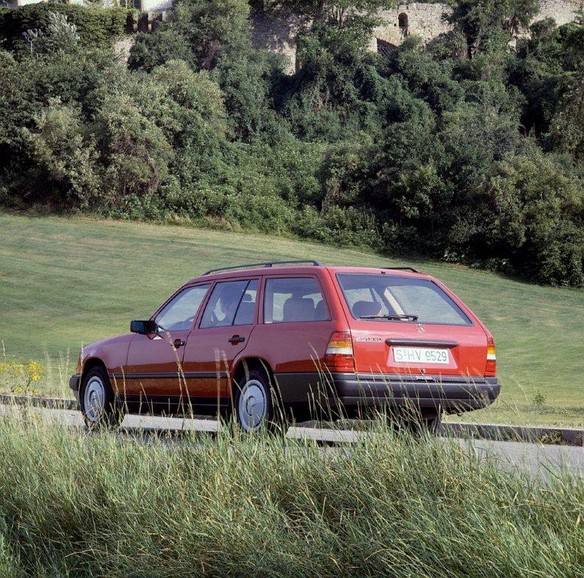
From September 1986 on the carburettor model too was available with emission control system. At that point the closed-loop catalytic converter was standard equipment for all Mercedes-Benz car models with petrol engines. The retrofit vehicles now only were available as an optional extra (with an appropriate reduction in price). This offer was discontinued in August 1989.
As had been the practice for decades in the intermediate range of Mercedes-Benz, partially bodied chassis also were available in the 124 series. They were made into ambulances, hearses or other special versions by domestic and foreign bodybuilders. New was that for the first time these chassis were based on the Estates and were manufactured together with them in Bremen. Along with the standard-wheelbase variant, available as 250 D and 230 E, additionally there was again a long-wheelbase version offered as 250 D, 230 E and 260 E. Ambulance bodies on these chassis originated mainly at Binz in Lorch, Miesen in Bonn and Visser in Leeuwarden, Netherlands. The best-known manufacturers of 124-based hearses included bodybuilders Pollmann in Bremen, Rappold in Wülfrath, Stolle in Hanover and Welsch in Mayen.
1988: Cleaner turbodiesels
Another Estate model followed in September 1988 at the Paris Motor Show, the 200 TE (90 kW) with the proven two-litre injection engine of the 190 E. Other changes affecting the Estates from September 1988 on concerned the turbocharged diesel engine of the 300 TD Turbo and 300 TD Turbo 4MATIC models and emphasised the reduction of particulate emissions through improvements to the combustion process. This objective was achieved by using a newly designed prechamber featuring oblique fuel injection, which ensured more efficient combustion. A pleasant side effect of the new diesel technology was a 2.9 kW increase in output.
In September 1988 all models of the series had their standard equipment extended. It now included the anti-lock braking system ABS and a heated nearside exterior mirror. On this occasion the windscreen washing system adopted from the S-Class was fitted with a heated washer reservoir and heated nozzles and hoses.
1989: The Diesel ’89 initiative
As part of the “Diesel ’89” initiative, in February 1989 the non-turbocharged diesel cars also were equipped with revised engines and also got the new oblique injection prechambers. In the naturally aspirated engines, too, the new diesel technology resulted in an increase in output, 2.2 kW in the 200 TD and 2.9 kW in the 250 TD and 300 TD. In addition, the injection pumps of all naturally aspirated diesel engines got an altitude correction unit to minimise emissions in operation at higher altitudes. The improved models, whose particulate emissions declined by 40 percent, met the stringent particulate limits applicable in the USA even without a particulate trap and operated almost entirely smoke-free. Pollutant emissions were reduced still further with the aid of a complex emission control system in which an oxidising catalytic converter specifically developed for diesel engines was combined with a carefully coordinated exhaust gas recirculation function. This very efficient system was available as an optional extra from October 1990 for diesel cars with naturally aspirated engines, and six months later also for the models with turbocharged engines.
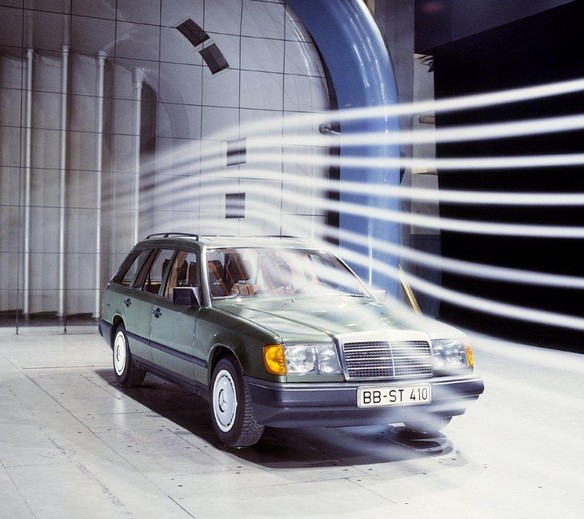
1989: Facelift for the intermediate class
In September 1989 at the Frankfurt International Motor Show Mercedes-Benz showed a completely revised intermediate-class model range. The model refinements focussed on changes to the styling of the body and the redesign of the interior. The most conspicuous feature of the facelifted models was the side rub strips with integral side skirts, which the Coupé models had received in similar form two-and-a-half years earlier. At the upper edges of the side skirts, narrow polished stainless steel trim strips additionally now were fitted and continued along the tops of the front and rear aprons. In a discreet form they brought back that often missed touch of sparkling chrome after a long period of abstinence. They were complemented with chrome trim elements on the door handles and changed wheel embellishers in which the Mercedes star and a narrow trim ring on the circumference also were chrome-plated. Another new feature were exterior mirror housings painted the colour of the car. The interior also presented itself in a new design offering improved front and rear seats and numerous improvements to details.
For all series 124 models with the exception of the 4MATIC variants, from September on the Sportline package familiar from the Compact Class models also was available as an optional extra. External features were the sports suspension with wide-base tyres size 205/60 R 15 on 7 J x 15 light-alloy or steel rims and a distinctly lower-slung body. The other appointments of the package included stiffer springs and shock absorbers along with modified interior appointments with a leather-covered steering wheel and gearshift lever as well as individual front and rear seats.
Four-valve-per-cylinder technology in series 124
The revised series 124 model range offered five entirely new models as well, including the 300 TE-24 with a four-valve-per-cylinder three-litre six-cylinder engine and variable intake camshaft. The unit came from the 300 SL-24 sports car. Owing to the different installation conditions, however, in the intermediate series it was not possible to use the same catalytic converter cross-section as in the SL. For this reason the rated output of 162 kW was 8.1 kW lower than in the sports car (170 kW).
In June 1992 the 2,000,000th vehicle of the 124 series rolled off the assembly line. Just a few weeks later the intermediate class again got a major facelift. This time Mercedes-Benz concentrated on the engine and appointments. The petrol-powered models presented themselves with a thoroughly revised engine range, completely converted to four-valve-per-cylinder technology and, in the 2.2-litre unit, to twin overhead camshafts with a variable intake camshaft. The four-cylinder units with two and 2.2 litres displacement in the 200 TE (100 kW) and 220 TE (110 kW) were from the M 111 series. The new engines were distinguished by increased output and higher torque over the entire engine speed range; all the same, they had lower fuel consumption. Due to an increase in the volume of the catalytic converter the pollutant emissions also were reduced.
As successors to the two-valve-per-cylinder six-cylinder unit and the three-litre four-valve unit, four-valve-per-cylinder engines with displacements of 2.8 and 3.2 litres now powered the 280 TE (145 kW) and 320 TE (162 kW). These engines, like the old three-litre four-valve unit, belong to the M 104 series, but have a changed bore-to-stroke ratio. All four- and six-cylinders now had the same bore. This facilitated flexible, economical manufacture. The new 2.8-litre engine surpassed the proven two-valve-per-cylinder engines of the M 103 model family in power and torque without consuming more fuel. In the 3.2-litre variant, which was already providing good service in the
S-Class, the rated output was the same as that of the old three-litre four-valve unit, but it was reached at an earlier point. Despite the obvious advantages of the new power plant, the three-litre engine remained in the range for the time being to power the 4MATIC models and the Cabriolet.
Apart from the new petrol engine range, the model refinements included distinctly upgraded standard appointments for all models of the intermediate class. Airbag, central locking and electrically adjustable exterior mirrors on both sides were part of the standard specifications from October 1992 on. In addition, the four-cylinder models, too, were equipped with a five-speed transmission at no extra charge.
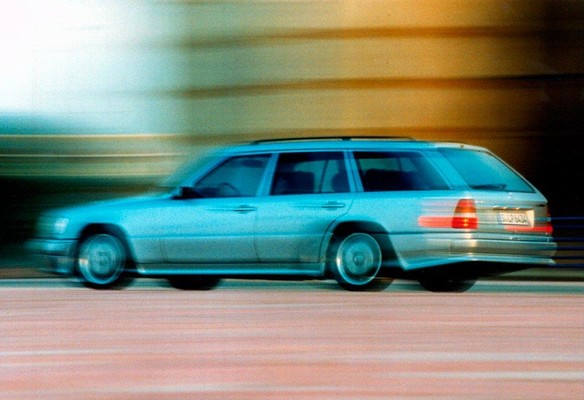
1993: Four-valve-per-cylinder diesel
As world first, in 1993 the four-valve-per-cylinder technology found its way into the diesel models as well. The new technology guarantees not only enhanced torque and power over a substantially larger engine speed range, but even cuts full-load fuel consumption by as much as eight percent. On top of that the optimised combustion process slashed particulate emissions in the exhaust gas by around 30 percent. Mercedes-Benz only changed the five- and six-cylinder naturally aspirated engines to the four-valve system, the two-litre four-cylinder and the two turbocharged engines retained the two-valve-per-cylinder configuration. Fresh-air intake in the four-valve diesel models was effected by means of five louvres on the right front wing, as was already the case in the turbocharged variants. To further improve environmental compatibility, from June 1993 on all diesel models of the 124 series were fitted as standard with exhaust gas recirculation and oxidising catalytic converter.
As part of the model refinements, finer points of the 2.8-litre six-cylinder engine of the 280 TE once again were changed. But this time it was not mainly a question of new technology. Instead the rated output was reduced by three kW to 142 kW to give the model a better third-party insurance classification in Germany.
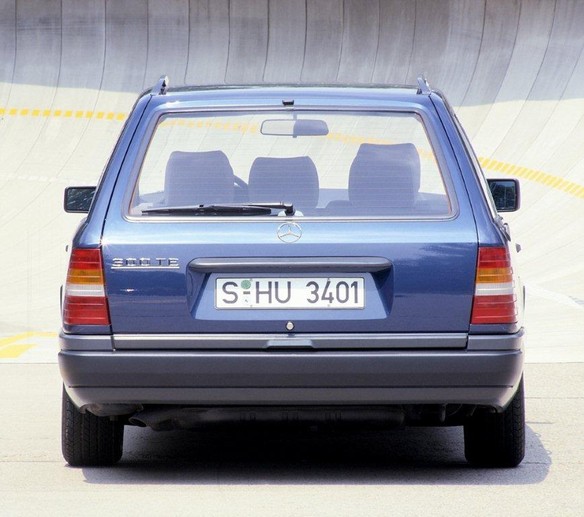
Updated styling
From June 1993 on the Mercedes-Benz designers revised the bodies of all series 124 models, updating them stylistically and adapting them to the other model series. The most striking feature of the modified vehicles was the radiator grille, which was redesigned after the
S-Class. This so-called integrated radiator features a much narrower chrome surround compared with the previous design, and the Mercedes star sat on the bonnet, as in the S-Class Saloons. The light units also were changed: colourless glass covers on the front direction indicators and bichromatic covers on the tail lights.
Changes also were made to the shape of the boot lid, to the wheels and to the bumpers. Among other things, the steel disc wheels got new hub caps in a six-hole design, and the protective mouldings on the bumpers now were painted the colour of the other detachable parts. In addition, the protective strip on the rear bumper was extended to the wheel cut-outs.
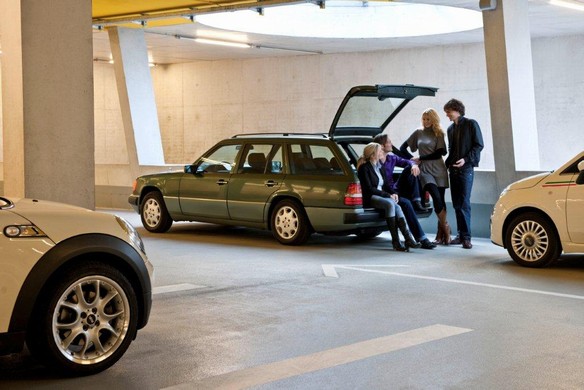
From the intermediate class to the E-Class
With the start of the sale of the redesigned models, in June 1993 a new nomenclature came into effect for the 124 series. In analogy to the S-Class and the new C-Class the intermediate class now was called the E-Class. The model designations, too, now followed a modified system in which letters documented that a car belonged to a certain class. The letter(s) were followed by a three-digit number which still was based on engine displacement. The formerly customary E as suffix indicating a petrol engine with fuel injection might have caused confusion, but this abbreviation could be dropped since there were no more carburettor engines in the range. For the future, Mercedes dispensed with codifying body variants like the coupé and estate, which were obvious anyway.
In the case of the diesel-engined models, a postpositive “Diesel” or “Turbodiesel” replaced the previous letter symbols. Applying the new rules, the Estate model 300 TD, for example, got the designation “E 300 Diesel”. However, the “DIESEL” signage on the right of the boot lid could be omitted on request, as could model plates in general.
An aura of greater sportiness was spread by the new Estate model E 36 AMG, which the “corporate tuners” offered with the M 104 3.6-litre six-cylinder and which likewise came out on the market in 1993. Its output was 200 kW at 5750 rpm.
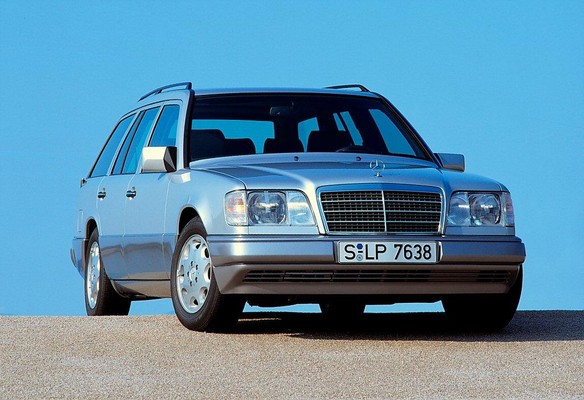
Taking leave of the first E-Class
In June 1995, two years after the last extensive facelift,
Mercedes-Benz introduced the E-Class Saloons of series 210, the successor to the 124 series. Production of the 124 series Saloons ended a short time later, between June and August 1995 depending on model. The Estate continued to be built until 1996. All in all, in the eleven-year-plus production period 340,503 Estates and 6398 chassis for special bodies were manufactured, for a total of 346,901 vehicles – not much compared with the 2,213,167 Saloons, but enough to give the Estate variant of the mid-range Mercedes-Benz a lasting place in the automotive world.
Production figures for the Estate models of the Mercedes-Benz 124 series
| Models | Internal designation | Production period: preproduction to end | Number of units |
| 200 TD | 1985 – 1991 | 7373 | |
| 250 TD | S 124 D 25 | 1985 – 1993 | 43,628 |
| 300 TD | S 124 D 30 | 1986 – 1993 | 21,901 |
| 300 TD Turbo/E 300 Turbodiesel Estate | S 124 D 30 A | 1986 – 1996 | 14,844 |
| 300 TD Turbo 4MATIC/ E 300 Turbodiesel 4MATIC Estate | S 124 D 30 A 4-M | 1987 – 1995 | 2317 |
| 250 TD Turbo / E 250 Turbodiesel Estate * | S 124 D 25 A | 1990 – 1996 | 4745 |
| E 250 Diesel Estate | S 124 D 25/2 | 1993 – 1996 | 15,625 |
| E 300 Diesel Estate | S 124 D 30/2 | 1993 – 1996 | 9071 |
| 200 T | S 124 V 20 | 1985 – 1990 | 7467 |
| 200 TE | S 124 E 20 | 1988 – 1992 | 20,555 |
| 230 TE | S 124 E 23 | 1985 – 1992 | 64,945 |
| 300 TE | S 124 E 30 | 1985 – 1992 | 41,775 |
| 300 TE 4MATIC/ E 300 4MATIC Estate | S 124 E 30 4-M | 1987 – 1995 | 12,094 |
| 300 TE-24 | S 124 E 30/2 | 1989 – 1992 | 6282 |
| 200 TE (engine M 111)/ E 200 Estate | S 124 E 20/2 | 1992 – 1996 | 15,279 |
| 220 TE/E 220 Estate | S 124 E 22 | 1992 – 1996 | 22,057 |
| 280 TE/E 280 Estate | S 124 E 28 | 1992 – 1996 | 12,177 |
| 320 TE/ E 320 Estate ** | S 124 E 32 | 1992 – 1996 | 18,368 |
| E 36 AMG Estate | S 124 E 36 | 1993 – 1996 | *** |
| Chassis | |||
| 250 D | F 124 D 25 | 1986 – 1993 | 741 |
| E 250 Diesel | F 124 D 25/2 | 1993 – 1995 | 301 |
| 230 E | F 124 E 23 | 1986 – 1992 | 224 |
| Chassis with long wheelbase | |||
| 250 D | VF 124 D 25 | 1985 – 1993 | 2331 |
| E 250 Diesel | VF 124 25/2 | 1993 – 1995 | 642 |
| 230 E | VF 124 E 23 | 1986 – 1992 | 711 |
| 260 E | VF 124 E 26 | 1986 – 1992 | 1049 |
| 280 E | VF 124 E 28 | 1992 – 1995 | 399 |
| Total | 346,901 |
* Export model not available in Germany
** Including E 36 AMG
*** Not separately documented
· Between 1985 and 1996 340,503 Estates rolled off the assembly line
· The all-wheel-drive system 4MATIC debuts in the 124 series
· The down-to-earth, functional design with modern lines impresses through clarity and timelessness
In 1984 Mercedes-Benz introduced the 124 series – the first family of vehicles that would be called the E-Class, though renaming did not occur until June 1993. At its debut, where traditionally only the Saloon is presented at first, the model designation followed the classic pattern. The history of the 124 series is marked by a previously unrivalled variety of models, body shapes and innovations. An important step in this connection was the presentation of the Estate in September 1985 at the International Motor Show in Frankfurt/Main.
This second generation of the sporty lifestyle Estate from Mercedes-Benz largely corresponds to the Saloon in its engineering and styling: apart from the deviating rear end design, the higher roof, and the changes which these gave rise to, there are no differences in the body. Major components, brake system and suspension merely were adapted to the higher payload, but otherwise were taken almost unchanged from the Saloon.
The safety standard achieved in the Saloon also was adopted as much as possible for the Estate models by the design engineers. In particular, the latest findings of safety research entered into the development of the rear body overhang, an especially critical region in estate car rear ends. One example is the fuel tank, which for design reasons is suspended underneath the vehicle floor in the Estates. It was given a special shape with sloping faces on the upper side of the tank and the vehicle floor. This ensures that in a rear-end collision involving deformation of the side members the tank is pushed down and away, but held by check straps so that it does not impact the road surface.
High-strength sheet steel and other weight-reducing materials already were used in the compact models of the 201 series. In the 124 series, despite lightweight construction the Mercedes-Benz engineers further improved the vehicle safety taking the 201 series and series 126
S-Class as benchmarks. The passenger compartment of the 124 series is distinguished by high side impact and rollover resistance and is provided with ingenious deformation zones in the front end and in the rear. The criterion of an asymmetric frontal collision with 40 percent overlap at a speed of 55 km/h now also was met by the Saloons of the intermediate series. In addition, possible areas of contact were designed to yield on impact to protect pedestrians and cyclists.
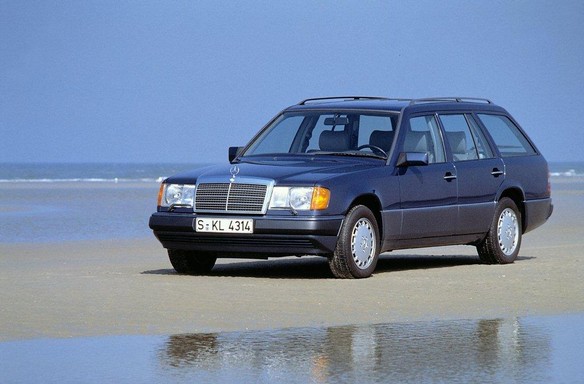
Individualist with family styling features
The design of the 124 series shows a family likeness to the compact models. On the whole, however, the new model series presented itself with independent design elements which had a functional background and were used for the first time. Bruno Sacco, Joseph Gallitzendörfer and Peter Pfeiffer were responsible for this design. The shape of the rear end both of the Saloon and the Estate had an especially favourable effect on drag resistance and was the product of wind tunnel testing. Aerodynamic optimisation measures resulted in a distinct reduction in fuel consumption versus the preceding model.
The much smaller Cd figure produced by the body design, as compared with the predecessor, brought a major improvement above all in fuel consumption. Compared with the Estate model with the internal designation S 123 the Cd was reduced from 0.42 to between 0.34 and 0.35, depending on engine.
An at first sight inconspicuous, but remarkably innovative design detail is the eccentric-sweep panoramic windscreen wiper. It wipes 86 percent of the windscreen – the biggest swept area of any car in the world at the time of the launching of the 124 series. Owing to a lifting motion superimposed on the rotary motion, the upper corners of the windscreen could be wiped far more efficiently than with a conventional single-arm wiper. Electrically heated windscreen washer nozzles were part of the standard equipment of all models of the series.
Chassis and engines
The front and rear suspension designs familiar from the compact models make for outstanding handling qualities. They include a shock absorber strut independent front suspension with anti-dive control, located by individual wishbones, and a multi-link independent rear suspension with each rear wheel located by five separate links and struts. The rear axle of the Estate models has hydropneumatic level control as standard.
The original Estate model range in the 124 series comprises seven models with different engines. The OM 601 of the 200 TD (53 kW) also powered the compact model 190 D with the same output. Other diesel models were the 250 TD (OM 602, 2.5 litres displacement, 66 kW) and the 300 TD with a three-litre six-cylinder (OM 603, 80 kW). In the 300 TD Turbo the 105 kW three-litre six-cylinder turbodiesel engine OM 603 A had its debut; the Mercedes-Benz engineers developed it from the naturally aspirated engine of the Saloon. The Estates with petrol engine were the four-cylinder models 200 T (80 kW) and 230 TE (100 kW) and the six-cylinder 300 TE (138 kW).
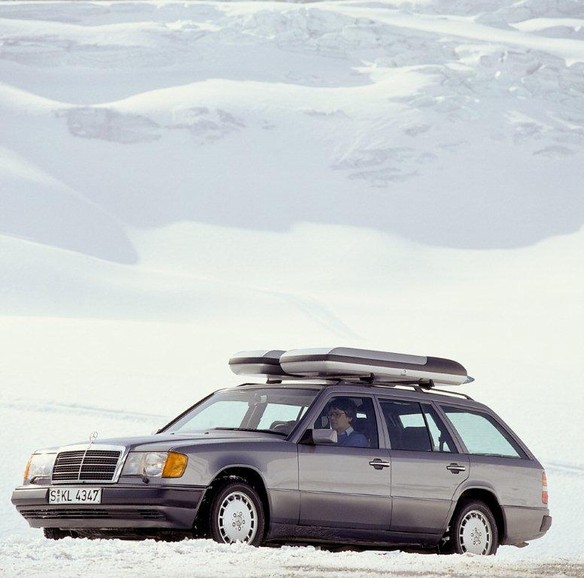
1985: 4MATIC is all-wheel-drive culture at Mercedes-Benz level
Simultaneously with the Estate models Stuttgart introduced the automatically engaged four-wheel-drive system 4MATIC as a part of the “Mercedes-Benz Driving Dynamics Concept”. This all-wheel-drive system was available for the six-cylinder models of the 124 series; in the Estate category the 300 TE 4MATIC and 300 TD Turbo 4MATIC could be had. Apart from the complex control electronics the 4MATIC features a complete additional front-wheel drive with transfer case and differential, with the latter integrated in the oil sump because of the installation constraints in the engine compartment.
The high technical sophistication of this perfected traction control system showed in the selling price: the 4MATIC models, whose delivery commenced in 1987, were almost 12,000 deutschmarks more expensive than their rear-wheel drive counterparts. In addition to the automatically engaged four-wheel-drive system 4MATIC the “Mercedes-Benz Driving Dynamics Concept” included the automatic locking differential and the acceleration skid control ASR. So in this package Mercedes-Benz altogether offered three graduated, electronic, automatic handling dynamics systems, all of which used the signals of the anti-lock braking system.
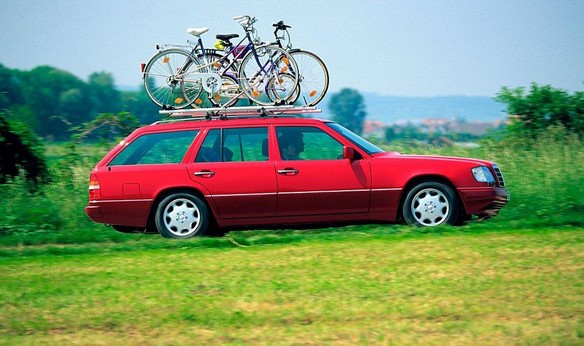
1986: Catalytic converter as standard in all Mercedes cars
As early as September 1985, for all petrol-engined models of the series except the carburettor-equipped 200 model a closed-loop emission control system with three-way catalytic converter was available as an optional extra. Alternatively a so-called catalyst retrofit version could be had in which the vehicle was provided without catalytic converter and oxygen sensor, but with the multifunctional mixture preparation and ignition system (MF system). This permitted retrofitting a vehicle with a closed-loop catalytic converter at any time and without any problems. This arrangement gave the customer the greatest possible flexibility in determining the time of conversion. In the 1980s that was a considerable advantage, as the supply of unleaded fuel was not yet ensured everywhere. The six-cylinder models were delivered in the catalyst retrofit version as standard. Their output was slightly reduced by the change to the MF system. In the models with the 2.3-litre engine the catalyst retrofit option only was available as an extra at first.
From September 1986 on the carburettor model too was available with emission control system. At that point the closed-loop catalytic converter was standard equipment for all Mercedes-Benz car models with petrol engines. The retrofit vehicles now only were available as an optional extra (with an appropriate reduction in price). This offer was discontinued in August 1989.
As had been the practice for decades in the intermediate range of Mercedes-Benz, partially bodied chassis also were available in the 124 series. They were made into ambulances, hearses or other special versions by domestic and foreign bodybuilders. New was that for the first time these chassis were based on the Estates and were manufactured together with them in Bremen. Along with the standard-wheelbase variant, available as 250 D and 230 E, additionally there was again a long-wheelbase version offered as 250 D, 230 E and 260 E. Ambulance bodies on these chassis originated mainly at Binz in Lorch, Miesen in Bonn and Visser in Leeuwarden, Netherlands. The best-known manufacturers of 124-based hearses included bodybuilders Pollmann in Bremen, Rappold in Wülfrath, Stolle in Hanover and Welsch in Mayen.
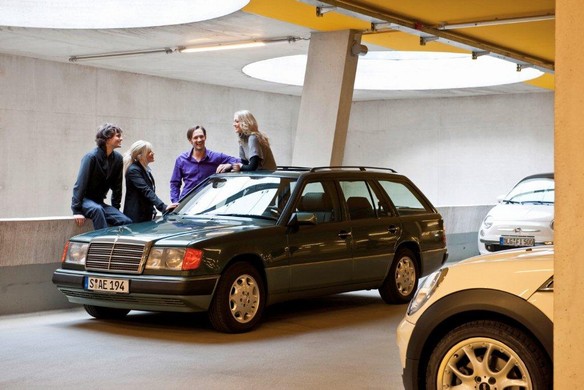
1988: Cleaner turbodiesels
Another Estate model followed in September 1988 at the Paris Motor Show, the 200 TE (90 kW) with the proven two-litre injection engine of the 190 E. Other changes affecting the Estates from September 1988 on concerned the turbocharged diesel engine of the 300 TD Turbo and 300 TD Turbo 4MATIC models and emphasised the reduction of particulate emissions through improvements to the combustion process. This objective was achieved by using a newly designed prechamber featuring oblique fuel injection, which ensured more efficient combustion. A pleasant side effect of the new diesel technology was a 2.9 kW increase in output.
In September 1988 all models of the series had their standard equipment extended. It now included the anti-lock braking system ABS and a heated nearside exterior mirror. On this occasion the windscreen washing system adopted from the S-Class was fitted with a heated washer reservoir and heated nozzles and hoses.
1989: The Diesel ’89 initiative
As part of the “Diesel ’89” initiative, in February 1989 the non-turbocharged diesel cars also were equipped with revised engines and also got the new oblique injection prechambers. In the naturally aspirated engines, too, the new diesel technology resulted in an increase in output, 2.2 kW in the 200 TD and 2.9 kW in the 250 TD and 300 TD. In addition, the injection pumps of all naturally aspirated diesel engines got an altitude correction unit to minimise emissions in operation at higher altitudes. The improved models, whose particulate emissions declined by 40 percent, met the stringent particulate limits applicable in the USA even without a particulate trap and operated almost entirely smoke-free. Pollutant emissions were reduced still further with the aid of a complex emission control system in which an oxidising catalytic converter specifically developed for diesel engines was combined with a carefully coordinated exhaust gas recirculation function. This very efficient system was available as an optional extra from October 1990 for diesel cars with naturally aspirated engines, and six months later also for the models with turbocharged engines.
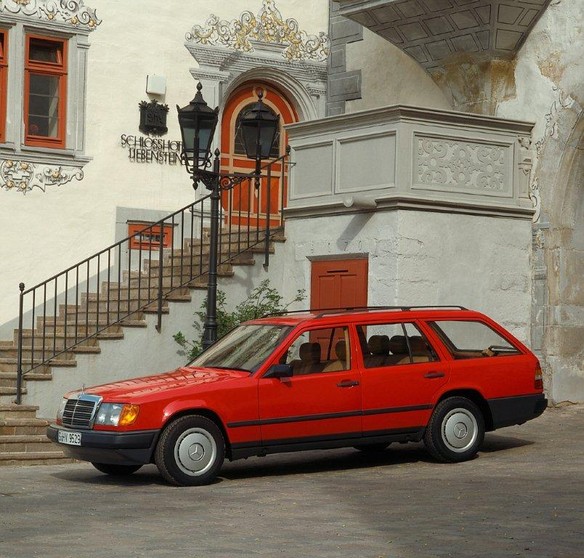
1989: Facelift for the intermediate class
In September 1989 at the Frankfurt International Motor Show Mercedes-Benz showed a completely revised intermediate-class model range. The model refinements focussed on changes to the styling of the body and the redesign of the interior. The most conspicuous feature of the facelifted models was the side rub strips with integral side skirts, which the Coupé models had received in similar form two-and-a-half years earlier. At the upper edges of the side skirts, narrow polished stainless steel trim strips additionally now were fitted and continued along the tops of the front and rear aprons. In a discreet form they brought back that often missed touch of sparkling chrome after a long period of abstinence. They were complemented with chrome trim elements on the door handles and changed wheel embellishers in which the Mercedes star and a narrow trim ring on the circumference also were chrome-plated. Another new feature were exterior mirror housings painted the colour of the car. The interior also presented itself in a new design offering improved front and rear seats and numerous improvements to details.
For all series 124 models with the exception of the 4MATIC variants, from September on the Sportline package familiar from the Compact Class models also was available as an optional extra. External features were the sports suspension with wide-base tyres size 205/60 R 15 on 7 J x 15 light-alloy or steel rims and a distinctly lower-slung body. The other appointments of the package included stiffer springs and shock absorbers along with modified interior appointments with a leather-covered steering wheel and gearshift lever as well as individual front and rear seats.
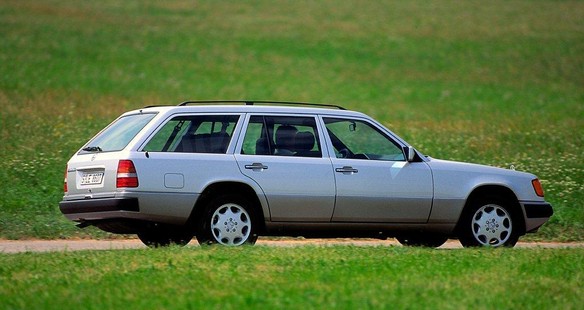
Four-valve-per-cylinder technology in series 124
The revised series 124 model range offered five entirely new models as well, including the 300 TE-24 with a four-valve-per-cylinder three-litre six-cylinder engine and variable intake camshaft. The unit came from the 300 SL-24 sports car. Owing to the different installation conditions, however, in the intermediate series it was not possible to use the same catalytic converter cross-section as in the SL. For this reason the rated output of 162 kW was 8.1 kW lower than in the sports car (170 kW).
In June 1992 the 2,000,000th vehicle of the 124 series rolled off the assembly line. Just a few weeks later the intermediate class again got a major facelift. This time Mercedes-Benz concentrated on the engine and appointments. The petrol-powered models presented themselves with a thoroughly revised engine range, completely converted to four-valve-per-cylinder technology and, in the 2.2-litre unit, to twin overhead camshafts with a variable intake camshaft. The four-cylinder units with two and 2.2 litres displacement in the 200 TE (100 kW) and 220 TE (110 kW) were from the M 111 series. The new engines were distinguished by increased output and higher torque over the entire engine speed range; all the same, they had lower fuel consumption. Due to an increase in the volume of the catalytic converter the pollutant emissions also were reduced.
As successors to the two-valve-per-cylinder six-cylinder unit and the three-litre four-valve unit, four-valve-per-cylinder engines with displacements of 2.8 and 3.2 litres now powered the 280 TE (145 kW) and 320 TE (162 kW). These engines, like the old three-litre four-valve unit, belong to the M 104 series, but have a changed bore-to-stroke ratio. All four- and six-cylinders now had the same bore. This facilitated flexible, economical manufacture. The new 2.8-litre engine surpassed the proven two-valve-per-cylinder engines of the M 103 model family in power and torque without consuming more fuel. In the 3.2-litre variant, which was already providing good service in the
S-Class, the rated output was the same as that of the old three-litre four-valve unit, but it was reached at an earlier point. Despite the obvious advantages of the new power plant, the three-litre engine remained in the range for the time being to power the 4MATIC models and the Cabriolet.
Apart from the new petrol engine range, the model refinements included distinctly upgraded standard appointments for all models of the intermediate class. Airbag, central locking and electrically adjustable exterior mirrors on both sides were part of the standard specifications from October 1992 on. In addition, the four-cylinder models, too, were equipped with a five-speed transmission at no extra charge.
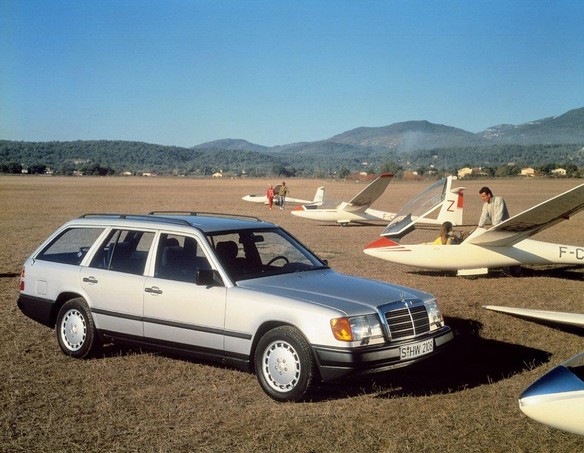
1993: Four-valve-per-cylinder diesel
As world first, in 1993 the four-valve-per-cylinder technology found its way into the diesel models as well. The new technology guarantees not only enhanced torque and power over a substantially larger engine speed range, but even cuts full-load fuel consumption by as much as eight percent. On top of that the optimised combustion process slashed particulate emissions in the exhaust gas by around 30 percent. Mercedes-Benz only changed the five- and six-cylinder naturally aspirated engines to the four-valve system, the two-litre four-cylinder and the two turbocharged engines retained the two-valve-per-cylinder configuration. Fresh-air intake in the four-valve diesel models was effected by means of five louvres on the right front wing, as was already the case in the turbocharged variants. To further improve environmental compatibility, from June 1993 on all diesel models of the 124 series were fitted as standard with exhaust gas recirculation and oxidising catalytic converter.
As part of the model refinements, finer points of the 2.8-litre six-cylinder engine of the 280 TE once again were changed. But this time it was not mainly a question of new technology. Instead the rated output was reduced by three kW to 142 kW to give the model a better third-party insurance classification in Germany.
Updated styling
From June 1993 on the Mercedes-Benz designers revised the bodies of all series 124 models, updating them stylistically and adapting them to the other model series. The most striking feature of the modified vehicles was the radiator grille, which was redesigned after the
S-Class. This so-called integrated radiator features a much narrower chrome surround compared with the previous design, and the Mercedes star sat on the bonnet, as in the S-Class Saloons. The light units also were changed: colourless glass covers on the front direction indicators and bichromatic covers on the tail lights.
Changes also were made to the shape of the boot lid, to the wheels and to the bumpers. Among other things, the steel disc wheels got new hub caps in a six-hole design, and the protective mouldings on the bumpers now were painted the colour of the other detachable parts. In addition, the protective strip on the rear bumper was extended to the wheel cut-outs.
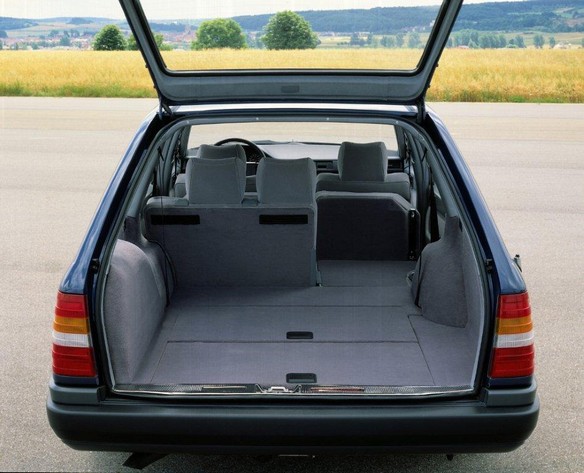
From the intermediate class to the E-Class
With the start of the sale of the redesigned models, in June 1993 a new nomenclature came into effect for the 124 series. In analogy to the S-Class and the new C-Class the intermediate class now was called the E-Class. The model designations, too, now followed a modified system in which letters documented that a car belonged to a certain class. The letter(s) were followed by a three-digit number which still was based on engine displacement. The formerly customary E as suffix indicating a petrol engine with fuel injection might have caused confusion, but this abbreviation could be dropped since there were no more carburettor engines in the range. For the future, Mercedes dispensed with codifying body variants like the coupé and estate, which were obvious anyway.
In the case of the diesel-engined models, a postpositive “Diesel” or “Turbodiesel” replaced the previous letter symbols. Applying the new rules, the Estate model 300 TD, for example, got the designation “E 300 Diesel”. However, the “DIESEL” signage on the right of the boot lid could be omitted on request, as could model plates in general.
An aura of greater sportiness was spread by the new Estate model E 36 AMG, which the “corporate tuners” offered with the M 104 3.6-litre six-cylinder and which likewise came out on the market in 1993. Its output was 200 kW at 5750 rpm.
Taking leave of the first E-Class
In June 1995, two years after the last extensive facelift, Mercedes-Benz introduced the E-Class Saloons of series 210, the successor to the 124 series. Production of the 124 series Saloons ended a short time later, between June and August 1995 depending on model. The Estate continued to be built until 1996. All in all, in the eleven-year-plus production period 340,503 Estates and 6398 chassis for special bodies were manufactured, for a total of 346,901 vehicles – not much compared with the 2,213,167 Saloons, but enough to give the Estate variant of the mid-range Mercedes-Benz a lasting place in the automotive world.
Production figures for the Estate models of the Mercedes-Benz 124 series
| Models | Internal designation | Production period: preproduction to end | Number of units |
| 200 TD |
| 1985 – 1991 | 7373 |
| 250 TD | S 124 D 25 | 1985 – 1993 | 43,628 |
| 300 TD | S 124 D 30 | 1986 – 1993 | 21,901 |
| 300 TD Turbo/E 300 Turbodiesel Estate | S 124 D 30 A | 1986 – 1996 | 14,844 |
| 300 TD Turbo 4MATIC/ | S 124 D 30 A 4-M | 1987 – 1995 | 2317 |
|
|
|
|
|
| 250 TD Turbo / E 250 Turbodiesel Estate * | S 124 D 25 A | 1990 – 1996 | 4745 |
|
|
|
|
|
| E 250 Diesel Estate | S 124 D 25/2 | 1993 – 1996 | 15,625 |
| E 300 Diesel Estate | S 124 D 30/2 | 1993 – 1996 | 9071 |
|
|
|
|
|
| 200 T | S 124 V 20 | 1985 – 1990 | 7467 |
| 200 TE | S 124 E 20 | 1988 – 1992 | 20,555 |
| 230 TE | S 124 E 23 | 1985 – 1992 | 64,945 |
| 300 TE | S 124 E 30 | 1985 – 1992 | 41,775 |
| 300 TE 4MATIC/ | S 124 E 30 4-M | 1987 – 1995 | 12,094 |
| 300 TE-24 | S 124 E 30/2 | 1989 – 1992 | 6282 |
| 200 TE (engine M 111)/ | S 124 E 20/2 | 1992 – 1996 | 15,279 |
| 220 TE/E 220 Estate | S 124 E 22 | 1992 – 1996 | 22,057 |
| 280 TE/E 280 Estate | S 124 E 28 | 1992 – 1996 | 12,177 |
| 320 TE/ | S 124 E 32 | 1992 – 1996 | 18,368 |
|
|
|
|
|
| E 36 AMG Estate | S 124 E 36 | 1993 – 1996 | *** |
| Chassis |
|
|
|
| 250 D | F 124 D 25 | 1986 – 1993 | 741 |
| E 250 Diesel | F 124 D 25/2 | 1993 – 1995 | 301 |
|
|
|
|
|
| 230 E | F 124 E 23 | 1986 – 1992 | 224 |
| Chassis with long wheelbase |
|
|
|
| 250 D | VF 124 D 25 | 1985 – 1993 | 2331 |
| E 250 Diesel | VF 124 25/2 | 1993 – 1995 | 642 |
|
|
|
|
|
| 230 E | VF 124 E 23 | 1986 – 1992 | 711 |
| 260 E | VF 124 E 26 | 1986 – 1992 | 1049 |
| 280 E | VF 124 E 28 | 1992 – 1995 | 399 |
| Total |
|
| 346,901 |
* Export model not available in Germany
** Including E 36 AMG
*** Not separately documented
